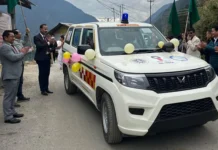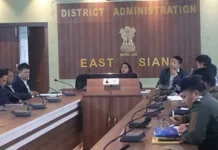[ Tongam Rina ]
ITANAGAR, Feb 22: The ambitious double East-West Industrial Corridor road, which is proposed to connect the state’s foothill districts without passing through Assam, will pass through the heart of the Pakke Tiger Reserve (PTR) to connect Seijosa in Pakke-Kessang district with Bhalukpong in West Kameng.
The 692.70 km long industrial corridor would run along the foothills on the boundaries of Arunachal and Assam. The detailed project report (DPR), which this daily was able to access, consists of two phases: Phase-I, from Pasighat to Bhairabkhund (539.00 kms), and Phase-II, from Kanubari to Manmao (153.70 kms).
According to the DPR which was presented to the high-powered committee (HPC) on the road project, Ahmedabad (Gujarat)-based consultancy firm, Nektor Engineers & Project Consultants (NEPC), proposes an elevated corridor that will pass through the 40 km stretch from Seijosa to Bhalukpong.
According to information procured under the RTI Act by environmental activist Tana Jorjo Tara, the PTR’s DFO had in a letter to the highway department’s chief engineer in July 2018 suggested that an alternative route be taken up instead laying one through the PTR, citing the Forest Conservation Act (FCA) and the Wildlife Protection Act (WPA), 1972.
The objection raised by the DFO has been noted in the DPR by the consultant.
Under the FCA, any kind of survey, investigation and exploration is not permitted to be carried out inside national parks and wildlife sanctuaries by any agency. Even the forest department is not permitted to demarcate sample plots without obtaining prior approval of the National Board of Wildlife (NBWL) and the Supreme Court.
Under the WPA, no alteration in the boundary of a tiger reserve shall be made, except on recommendation of the National Tiger Conservation Authority and the approval of the NBWL.
The elevated corridor through the PTR is estimated at Rs 2550 crore.
The second option is via the Pakke-Kessang road, through the boundary of the PTR. It proposes an “elevated corridor in valley and deep gorges and identified animal corridor” – a length of 48.8 kms within the park, at a cost of Rs 2452.8 crore.
The proposed elevated corridor “can ensure free movement of wild animals in protected areas,” it says, adding in the next line that “extra fencing shall be provided along the project road other than underpass or overpass portion to restrict the trespassing and unauthorized entry in core zone.”
The DPR proposes three options: via upstream of the NHPC dam and through Subansiri-Naharlagun-Seijosa-PTR (elevated corridor)-Bhalukpong (534.90 kms); via upstream of the NHPC dam and through Subansiri-Naharlagun-Seijosa-PTR boundary-Nechiphu-Bhalukpong (717.30 kms); and via upstream of the NHPC dam and through Subansiri-Naharlagun-Seijosa-Pakke-Kessang-Seppa-Nechiphu-Bhalukpong (748.90 kms).
The NHPC authorities are reported to have turned down the proposal to allow the industrial corridor to pass through its bridge over the Subansiri river, which has led to the proposal of realigning the road well towards upstream of the dam.
On 5 February this year, the HPC, headed by Legislative Assembly Speaker PD Sona, approved the DPR for the East-West Industrial Corridor.
“This project has been conceptualized for enhancing better connectivity of foothills region and developing the foothill areas of the state into economic and industrial zones,” a press statement read.
According to the statement, the DPR will be submitted to the state government for onward submission to the central government during this current financial year for allocation of fund.
The road project, which was conceived in 1990 and would pass through East Siang, Lower Siang, Kamle, Papum Pare, East Kameng and West Kameng districts, offers no land compensation. Land has to be given for free by the citizens.
“The road, apart from facilitating road connectivity during frequent bandh calls and strikes in Assam… will serve as a vital link for carriage of heavy machineries for hydropower projects in the state,” the DPR reads.
DPR, satellite imageries, forests and MoRTH guidelines
The DPR was prepared using satellite imageries, without any consultation with the forest department.
Speaking to this daily, an NEPC employee in charge of the DPR said satellite imageries were used because the forest department did not give permission to visit the tiger park.
The DPR cost itself runs into crores of rupees, raising the question of why the finalization of the draft DPR could not wait, forcing the firm to use satellite imageries.
The consultants did not seek any kind of permission from the forest department in Itanagar, or from the PTR DFO, before finalizing the draft DPR. The NEPC has instead asked the forest department to help in getting clearance according to the DPR.
According to the laid down guidelines, the DPR is in violation the ministry of environment, forest & climate change (MoEFCC) guidelines as prior permission is required from the forest department before undertaking any activity within protected areas.
In a letter it sent to the chief wildlife wardens of all the states and union territories, the MoEFCC said all the linear infrastructure projects seeking clearance from the standing committee of the NBWL must mandatorily contain an animal passage plan, and that if there is no plan, such proposals should not be sent to the NBWL. The letter was sent in July 2018.
In May 2019, the ministry of road transport & highways (MoRTH) in a letter to the chief secretaries of the states and the BRO on the principles to be adopted while considering constructing highways near or within wildlife sanctuaries, national parks and animal corridors said that in order to ensure minimum impact of highways on protected eco-sensitive areas, the implementing agency should consider sparing sanctuaries and national parks at the planning stage and, wherever possible, take a bypass/detour.
However, if it is absolutely unavoidable, all necessary clearances required under the Wildlife Protection Act, 1972, the Forest Conversion Act, 1980, and the Environment (Protection) Act, 1986, should be obtained before any work is undertaken in such areas, it said.



